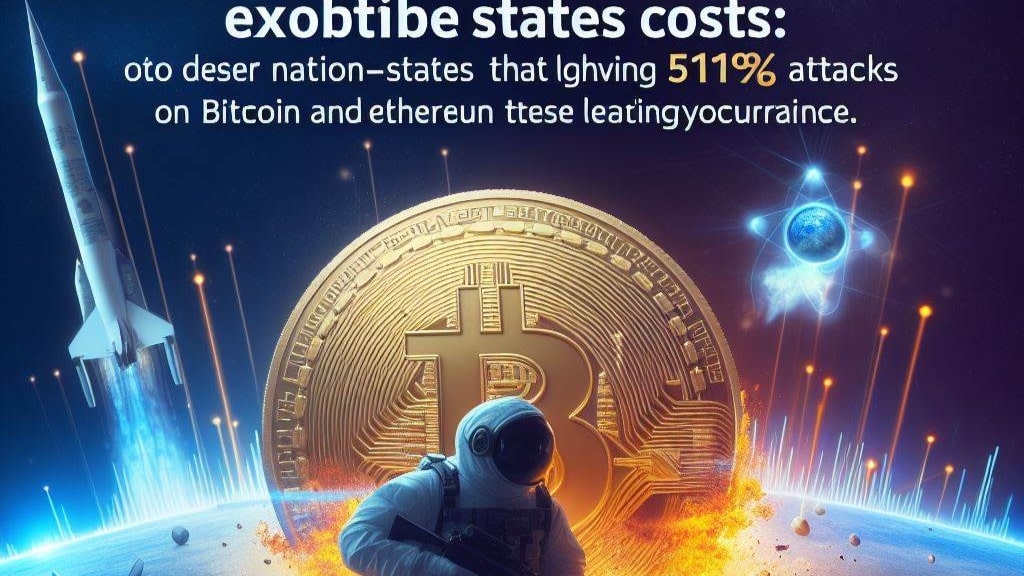In the ever-evolving landscape of cryptocurrencies, security remains paramount. Recent research from Coin Metrics has cast light on the formidable defenses of Bitcoin (BTC) and Ethereum (ETH) against the looming threat of 51% attacks.
Delving deep into the intricacies of blockchain security, this article unveils the impracticality of such malicious endeavors, elucidating the insurmountable financial barriers that safeguard the integrity of these decentralized networks.
Introduction: The Peril of 51% Attacks
In the realm of cryptocurrencies, the specter of 51% attacks looms large, instilling fear and uncertainty among investors and enthusiasts alike. A 51% attack, a malicious act wherein an individual or entity gains majority control over a blockchain network’s hash rate or staked assets, poses a grave threat to the integrity and trustworthiness of the system. However, recent revelations from Coin Metrics have shattered the myth of these attacks’ feasibility, showcasing the resilience of Bitcoin and Ethereum against such nefarious exploits.
Unveiling the Research: Coin Metrics’ Groundbreaking Findings
Led by a team of seasoned researchers including Lucas Nuzzi, Kyle Water, and Matias Andrade, Coin Metrics embarked on a groundbreaking exploration to assess the viability of 51% attacks on Bitcoin and Ethereum networks. Their research delved deep into the intricacies of blockchain security, analyzing the cost implications and practicality of executing such attacks in today’s landscape.
The Total Cost to Attack: A Revolutionary Metric
At the heart of Coin Metrics’ research lies the innovative concept of the “Total Cost to Attack” (TCA) metric. This groundbreaking measure quantifies the financial outlay required to orchestrate a successful 51% attack on blockchain networks. Through meticulous analysis and empirical data, Coin Metrics sought to dispel the notion of these attacks’ feasibility by highlighting the exorbitant costs involved.
Bitcoin: Fortifying the Digital Gold
Bitcoin, often heralded as digital gold, stands as the cornerstone of the cryptocurrency ecosystem. Coin Metrics’ research revealed that launching a 51% attack on the Bitcoin network would necessitate the acquisition of a staggering number of ASIC mining rigs, totaling billions of dollars in investment. Moreover, even in the most lucrative scenarios, where potential gains could outweigh the costs, the rate of return remains meager, rendering such attacks financially unviable for nation-states and malicious actors.
Ethereum: Shielding the World Computer
As the foundation of decentralized finance (DeFi) and smart contracts, Ethereum represents the backbone of the blockchain revolution. Coin Metrics’ findings underscored the robust defenses of Ethereum against 51% attacks, showcasing the impracticality of such endeavors. Leveraging Liquid Staking Derivatives (LSDs) to manipulate the Ethereum network would entail astronomical costs and logistical challenges, dissuading potential attackers from pursuing such malicious exploits.
Praise for Rigorous Research: Industry Acknowledgment
Coin Metrics’ research garnered widespread acclaim within the cryptocurrency community, with industry experts lauding the team’s meticulous approach and empirical analysis. Notable figures such as Castle Island Ventures partner Nic Carter commended the research for its rigorous methodology and groundbreaking insights. The findings from Coin Metrics have reshaped the discourse surrounding blockchain security, instilling confidence in the resilience of Bitcoin and Ethereum networks against adversarial threats.
Conclusion: Safeguarding the Future of Finance
In conclusion, Coin Metrics’ research has shed light on the impracticality of 51% attacks on Bitcoin and Ethereum, showcasing the robust security measures that underpin these leading cryptocurrencies. As the digital frontier continues to evolve, the fortitude of Bitcoin and Ethereum against malicious exploits serves as a beacon of hope for the decentralized future of finance. By fortifying the citadel of blockchain security, we pave the way for a more secure and resilient financial ecosystem, safeguarding the promise of decentralization for generations to come.
